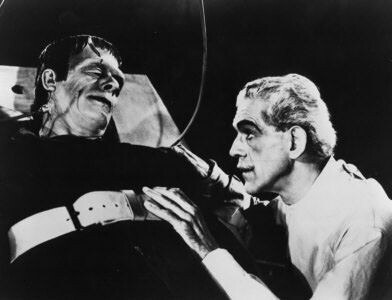
In her novel Shelley relates in the form of letters and memoirs the events of the life of young Victor Frankenstein, the son of a Genevese doctor and diplomat. Victor aspires to become a doctor himself and seeks his education in Wittenburg, where he meets a mysterious professor of the College of Medicine, Doctor Oleaus Snape. Snape is secretive and only after much pleading does he allow Victor entrance to his secret laboratory, which he tells Victor he must secure for himself if he is to become a serious scientist. Victor promises to run out and purchase a crumbling mill or slaughterhouse that very afternoon.
Victor learns much from Snape, including the teachings of Paracelcus, Cornelius Agrippa, Albertus Magnus, the Philosopher’s Stone, and the Tesla’s coil. With this new knowledge he is worked up into a furor, toiling in his secret laboratory night and day to come up with a really neat experiment to conduct, something impossibly complex with high voltage that’s impervious to peer review. After a string of sleepless nights he strikes upon the pinnacle of scientific achievement: He will create a Frankenstein.
In his zeal Victor skipped the planning phase and went straight to the naming phase, and he was already quite proud of his invention. There would be loud crashes of blinding sparks, massive gears and swooping platforms as his experiment summoned the might of the gods to complete. Finally he decides he will adapt ancient descriptions of alchemists’ experiments with homunculi for something similar on a larger scale. Securing a more or less agreeable bouquet of corpses he sews and knits and staples and glues and bolts together a form so amazing he is proud to call it the Frankenstein Mark 1.
But what is a Frankenstein? This is a matter of some debate, both within the narrative and among present-day scholars. By all outward appearances a mindless, unfeeling, hideous brute composed of the dead, Frankenstein is also known to attempt speech, and with his creator holds forth most persuasively, by perhaps some innate talent, or perhaps simply flattered by Victor’s own considerable guilt.
Upon his creation Frankenstein fled his master, and is next heard of in the frightened alarums ringing up and down the countryside of a terrible monster, a Frankenstein to be sure, sailing children into wells and frightening kindly old blind men with his Cowardly Lion guffaw and constant references to someone called Lilly. Though eloquent on previous occasions, now the Frankenstein is chiefly heard to repeat one blunt, heartfelt opinion to the detriment of fire. He tries this argument on the villagers with torches and pitchforks, with whom he now seems to run a perpetual marathon.
The novel takes readers by surprise at this point by introducing a new major character in the third act. Word of the terror spread by Frankenstein reaches Castle Dracula in Transylvania, which is a short journey from Lake Geneva. Jealous of what would appear to be a potential rival, Dracula sets out for Geneva at once to face Frankenstein and reassert his place as top spook.
Meanwhile Victor has been searching for Frankenstein himself, up and down the Alps and along the lake, but his creation seems visible only to frightened mobs, all of whom have just come back from the torch and pitchfork shop. Dracula finds Frankenstein first and a battle ensues. After a fierce contest of wills Frankenstein dives off a cliff to save a kitten and evil Dracula is triumphant. Yet he did not suspect that Victor had watched the entire proceedings with old Professor Snape and the two are ready, cross, stake and hammer in hand, to deal with the Dracula. They make quick work of the Dracula and return home in time find Van Helsing in a compromising attitude with the Bride of Frankenstein. Not knowing if she is Victor’s bride or the Frankenstein’s, the novel concludes with Victor roiled in a confused mixture of revulsion and jealousy, suggesting Shelley’s anticipation of the decadence of the oncoming consumer age.
I will have to refer all of our patrons to this when the Cliffs Notes are not available.
ReplyDelete